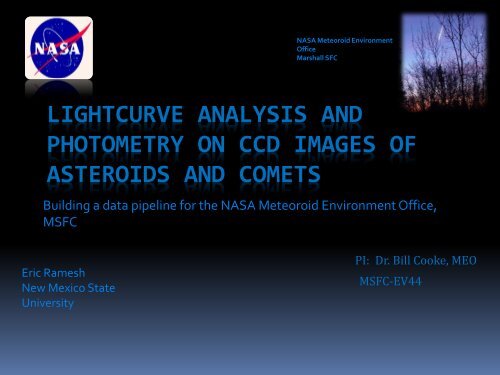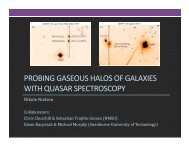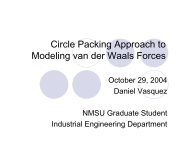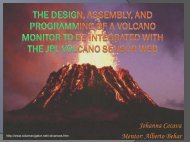Lightcurve Analysis and Photometry on CCD Images of Asteroids ...
Lightcurve Analysis and Photometry on CCD Images of Asteroids ...
Lightcurve Analysis and Photometry on CCD Images of Asteroids ...
Create successful ePaper yourself
Turn your PDF publications into a flip-book with our unique Google optimized e-Paper software.
NASA Meteoroid Envir<strong>on</strong>ment<br />
Office<br />
Marshall SFC<br />
LIGHTCURVE ANALYSIS AND<br />
PHOTOMETRY ON <strong>CCD</strong> IMAGES OF<br />
ASTEROIDS AND COMETS<br />
Building a data pipeline for the NASA Meteoroid Envir<strong>on</strong>ment Office,<br />
MSFC<br />
Eric Ramesh<br />
New Mexico State<br />
University<br />
PI: Dr. Bill Cooke, MEO<br />
MSFC-EV44
NASA Academy Summer ‘10
Why Study Rocks in Space?<br />
NASA’s new directi<strong>on</strong> includes a human<br />
missi<strong>on</strong> to a Near Earth Object (asteroid) by<br />
2025.<br />
A current hypothesis suggests the sporadic<br />
meteoroid background was produced by<br />
cometary breakups, rather than sublimati<strong>on</strong> <strong>of</strong><br />
ice <str<strong>on</strong>g>and</str<strong>on</strong>g> dust from comet surfaces.<br />
The sporadic meteoroid envir<strong>on</strong>ment<br />
c<strong>on</strong>sists <strong>of</strong> a diffuse background <strong>of</strong> meteoroids<br />
that represents a c<strong>on</strong>tinuous risk to spacecraft<br />
throughout the year. The Meteoroid<br />
Envir<strong>on</strong>ment Office (MEO) has developed the<br />
NASA MSFC Meteoroid Engineering Model<br />
(MEM) to define the sporadic meteoroid<br />
envir<strong>on</strong>ment for spacecraft in interplanetary<br />
space <str<strong>on</strong>g>and</str<strong>on</strong>g> Earth orbit.
Lunar Impact M<strong>on</strong>itoring<br />
Marshall SFC<br />
On average, 33 metric t<strong>on</strong>s (73,000 lbs) <strong>of</strong> meteoroids<br />
hit Earth every day, the vast majority <strong>of</strong> which harmlessly<br />
ablates ("burns up") high in the atmosphere, never<br />
making it to the ground. The mo<strong>on</strong>, however, has no<br />
atmosphere, so meteoroids have nothing to stop them<br />
from striking the surface.<br />
The slowest <strong>of</strong> these rocks travels at 20 km/sec (45,000 mph); the<br />
fastest travels at over 72 km/sec (160,000 mph). At such speeds even a<br />
small meteoroid has incredible energy -- <strong>on</strong>e with a mass <strong>of</strong> <strong>on</strong>ly 5 kg<br />
(10 lbs) can excavate a crater over 9 meters (30 ft) across, hurling 75<br />
metric t<strong>on</strong>s (165,000 lbs) <strong>of</strong> lunar soil <str<strong>on</strong>g>and</str<strong>on</strong>g> rock <strong>on</strong> ballistic trajectories<br />
above the lunar surface.<br />
Missi<strong>on</strong> statement: Use Earth-based observati<strong>on</strong>s <strong>of</strong> the<br />
dark porti<strong>on</strong> <strong>of</strong> the mo<strong>on</strong> to establish the rates <str<strong>on</strong>g>and</str<strong>on</strong>g> sizes <strong>of</strong><br />
large meteoroids (greater than 500 grams or 1 pound in<br />
mass) striking the lunar surface.<br />
http://www.nasa.gov/centers/marshall/news/lunar/program_overview.html
<str<strong>on</strong>g>Photometry</str<strong>on</strong>g> Primer<br />
<str<strong>on</strong>g>Lightcurve</str<strong>on</strong>g> photometry is the<br />
process <strong>of</strong> measuring the<br />
variati<strong>on</strong>s in brightness (magnitude<br />
or flux versus time) <strong>of</strong> a specific<br />
object, such as a comet or<br />
asteroid.<br />
<str<strong>on</strong>g>Lightcurve</str<strong>on</strong>g> analysis <strong>of</strong> comets<br />
<str<strong>on</strong>g>and</str<strong>on</strong>g> asteroids can reveal many<br />
traits including rotati<strong>on</strong> rate,<br />
rotati<strong>on</strong> axis, shape, <str<strong>on</strong>g>and</str<strong>on</strong>g><br />
compositi<strong>on</strong> (when imaged in<br />
multiple colors).
ALAMO & NM Skies Observatory<br />
Automated Lunar & Meteor Observatory<br />
ALAMO<br />
.5 Meter RCOS telescope w/ Apogee U9000 camera
Astr<strong>on</strong>omy by<br />
Ground-Based<br />
Observatory
Getting Started With S<strong>of</strong>tware: MPO<br />
Canopus
PhotoRed:<br />
Transforms &<br />
Extincti<strong>on</strong>s
Transforms<br />
From instrumental to st<str<strong>on</strong>g>and</str<strong>on</strong>g>ard<br />
UBVRI (Johns<strong>on</strong>-Cousins system)<br />
Graph <strong>of</strong> the transmittance <strong>of</strong> each filter<br />
as a functi<strong>on</strong> <strong>of</strong> wavelength.<br />
Wavelength units = micr<strong>on</strong>s.<br />
Wave B<str<strong>on</strong>g>and</str<strong>on</strong>g><br />
Center<br />
Frequency<br />
μm<br />
B<str<strong>on</strong>g>and</str<strong>on</strong>g> Width<br />
μm<br />
0<br />
Magnitude<br />
Flux<br />
(ergs s −1<br />
cm −2 μm −1 )<br />
ADPS <strong>on</strong>line database<br />
Lamla (1982) via the ADPS<br />
U 0.3500 0.0700 3.980 10 −5<br />
B 0.4380 0.0985 6.950 10 −5<br />
V 0.5465 0.8700 3.630 10 −5<br />
R 0.6470 0.1515 2.254 10 −5<br />
I 0.7865 0.1090 1.196 10 −5
First <str<strong>on</strong>g>and</str<strong>on</strong>g> Sec<strong>on</strong>d Order Extincti<strong>on</strong>s<br />
The presence <strong>of</strong> the atmosphere affects<br />
the transmissi<strong>on</strong> <strong>of</strong> the light<br />
Extincti<strong>on</strong> measures the dimming <strong>of</strong> light as it passes<br />
through the atmosphere (units <strong>of</strong> magnitudes/Air Mass meaning<br />
the larger the air mass, the more the extincti<strong>on</strong>).
First <str<strong>on</strong>g>and</str<strong>on</strong>g> Sec<strong>on</strong>d Order Extincti<strong>on</strong>s<br />
The value for extincti<strong>on</strong> is not the same for all colors. Red light is<br />
absorbed less by the earth’s atmosphere than blue light, the value for<br />
extincti<strong>on</strong> is lower for red light than blue.<br />
First order is the type <strong>of</strong> extincti<strong>on</strong> just described, i.e., the value for a<br />
fixed or narrow range <strong>of</strong> colors.<br />
Sec<strong>on</strong>d order extincti<strong>on</strong> is dependent <strong>on</strong> the color <strong>of</strong> the object being<br />
measured. (Mostly critical for stellar photometry – variable star<br />
observati<strong>on</strong>s)<br />
As the object moves towards the horiz<strong>on</strong> from its highest point in the<br />
sky, the blue porti<strong>on</strong> <strong>of</strong> its light is dimmed more rapidly than the red<br />
porti<strong>on</strong>. Therefore, to correctly compute the true "exospheric magnitude"<br />
<strong>of</strong> the star (magnitude as seen outside the earth’s atmosphere), <strong>on</strong>e must<br />
also determine the sec<strong>on</strong>d order extincti<strong>on</strong>.
PhotoRed: Transforms & Extincti<strong>on</strong>s<br />
M f = (m - k’ f X - k” f XCI) + T f CI + ZP f<br />
M f is the reduced magnitude <strong>on</strong> st<str<strong>on</strong>g>and</str<strong>on</strong>g>ard system<br />
m is instrumental magnitude<br />
k’ f is first order extincti<strong>on</strong> for filter (f)<br />
X is air mass<br />
k” f is the sec<strong>on</strong>d order extincti<strong>on</strong> for filter (f)<br />
T f is the transform for filter (f)<br />
CI is color index<br />
ZP f is the nightly zero point for filter (f)
The Ghosting Problem<br />
Residual Bulk <strong>Images</strong> (RBI):<br />
occur when l<strong>on</strong>g wavelength<br />
phot<strong>on</strong>s (such as in the IR<br />
spectrum) penetrate deeply<br />
enough to produce residual<br />
charge which is then carried over<br />
to the next exposure.<br />
SRIs are similar to RBIs but mainly caused<br />
by oversaturati<strong>on</strong> <strong>of</strong> the chip.<br />
SOLUTION: Switch cameras!<br />
(SBIG ST-10XME)<br />
Also, set the aut<strong>of</strong>ocus<br />
procedure <strong>on</strong>to a dimmer star.
PhotoRed Transforms / Extincti<strong>on</strong> Plots<br />
(BVR)<br />
Apogee<br />
U9000<br />
instrumental<br />
to st<str<strong>on</strong>g>and</str<strong>on</strong>g>ard<br />
magnitudes
Calibrati<strong>on</strong> Target: 21 Lutetia<br />
ESA<br />
Period <strong>of</strong> 8.2 h, in corresp<strong>on</strong>dence w/ actual period measurements (8.168 h)<br />
Amplitude (averaged) <strong>of</strong> roughly .26 m, agreeing with established lightcurve<br />
amplitude (0. m 25)
Comet CK75
C<strong>on</strong>clusi<strong>on</strong>: A Data Pipeline<br />
for the Future<br />
Through our testing <strong>of</strong> MPO Canopus <str<strong>on</strong>g>and</str<strong>on</strong>g> analysis<br />
<strong>of</strong> 21 Lutetia <str<strong>on</strong>g>and</str<strong>on</strong>g> other targets, we have established<br />
a data pipeline for the NASA Meteoroid Envir<strong>on</strong>ment<br />
Office. We eliminated potential bugs in the program,<br />
such as ghosting effects (Residual <strong>Images</strong>) caused<br />
by a variety <strong>of</strong> factors.<br />
Our pipeline has the potential to<br />
increase the body <strong>of</strong> knowledge for<br />
these objects, <str<strong>on</strong>g>and</str<strong>on</strong>g> could prove useful<br />
in target selecti<strong>on</strong> for future NASA<br />
missi<strong>on</strong>s.
SPECIAL THANKS:<br />
NASA Marshall SFC<br />
New Mexico Space Grant<br />
Alabama Space Grant<br />
Dr. Rob Suggs (MSFC Space Envir<strong>on</strong>ment Office)<br />
Matthew Hosek<br />
NASA Academy Teammates<br />
Dr. Frank Six (NASA MSFC Academy)<br />
Dr. William Gibbs (NMSU Physics)<br />
Dr. Michael Engelhardt (NMSU Physics)<br />
Dr. Nancy Chanover (NMSU Astr<strong>on</strong>omy)<br />
Questi<strong>on</strong>s?









